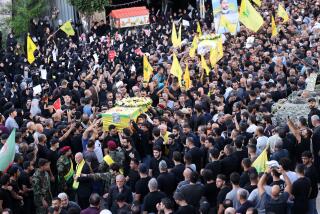No force ‘surge’ for Afghanistan
Defense Secretary Robert M. Gates ruled out a large “surge” of U.S. forces in Afghanistan but said Friday that a small number of additional troops were needed to counter increasing violence and train Afghan forces.
“You’re talking about probably somewhere in the neighborhood of 7,500 troops,” Gates said. “So it’s not like moving 100,000 troops from one place to the other or something like that.”
Commanders in Afghanistan, seeking to augment the 26,000 U.S. troops in the country, have asked for 3,500 police trainers and about 3,000 combat troops in addition to more helicopters and pilots and some smaller units.
Gates has been pressuring Washington’s North Atlantic Treaty Organization allies for more troops for the Afghan mission.
But he said Friday that there was little reason to press nations to send more troops if their domestic politics prohibited a greater military commitment to Afghanistan.
“Continuing to publicly go after our allies . . . to do things that politically are just impossible for them is probably not very productive,” he said.
Gates said the challenge of the year ahead in Afghanistan was to build on military successes, keep control of newly recaptured areas and start to push ahead on economic progress.
“There is no doubt . . . that there has been an increase in violence over the past year,” Gates said. “But in part it has been due to much more aggressive actions on the part of the NATO alliance and the U.S. forces that are there.”
It may become easier for the U.S. to send small numbers of additional troops to Afghanistan in 2008 as the American military presence in Iraq is expected to begin dropping.
The U.S. has about 158,000 troops in Iraq, a number that should gradually fall through the first half of next year as the Pentagon continues withdrawing combat brigades without replacing them.
Gates said he believed the security conditions in Iraq would allow the United States to continue to draw down its troops from 20 brigades to 15 in July.
The Defense secretary said he still hoped to reduce the U.S. force to 10 brigades by the end of next year. Although he avoided talking about specific troop counts, having 10 brigades in Iraq probably would mean a troop level of about 100,000.
“If we were to continue the withdrawals at the level of the first half of the year -- if the conditions permitted that -- then that would bring us down by the end of the administration to about 10 brigade combat teams,” Gates said.
Military leaders have emphasized that the reductions are dependent on conditions, both the state of security and Iraqi political progress.
The next major Iraq assessment is due in March, when Gates, military commanders and President Bush are expected to map out the troop presence between July and the end of the year.
In visits to Iraq this year, Gates tried to pressure Iraqi political leaders to cut deals and approve national reconciliation legislation. There has been little progress on such “benchmark” measures, and U.S. officials are now emphasizing the importance of “bottom-up” initiatives on the local level.
Asked Friday about progress by the Iraqi government, Gates said some Iraqi ministries were improving. And he said he had spoken to Iraqi leaders about pushing the reconciliation laws.
“They are committed to getting it done,” Gates said. “We’ll see if they get it done.”
--
Times staff writer Peter Spiegel contributed to this report.
More to Read
Sign up for Essential California
The most important California stories and recommendations in your inbox every morning.
You may occasionally receive promotional content from the Los Angeles Times.







